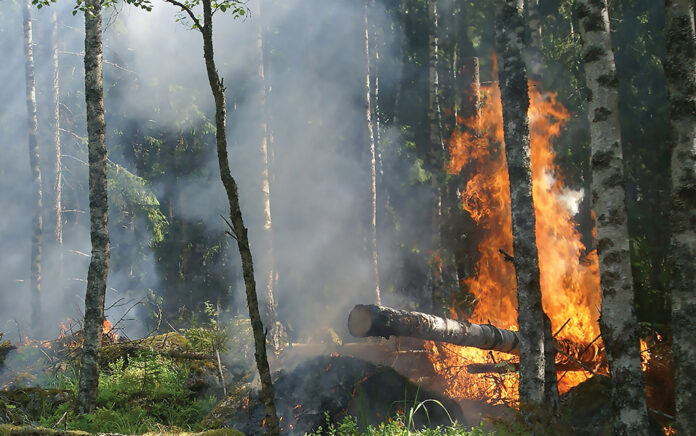For anyone struggling to make sense of climate change, a useful way to comprehend its impact is to ignore the big picture altogether. With climate change, it’s not so much about what happens in the wider scale of things that matters so much, it’s what happens at a local level that counts.
People living in the town of Lahaina on the island of Maui in Hawaii found this out to their absolute horror on August 8 when a wildfire tore through their beautiful and historic community, causing utter devastation. Unfortunately, they weren’t alone.
Two weeks later, as the news carried warnings of another approaching heatwave across southern Europe, authorities in Greece were also counting the cost of wildfires that took lives and livelihoods in several areas. At the same time, in Canada, firefighters neared the point of complete exhaustion as they battled blazes that forced the evacuation of over 30,000 households in the province of British Columbia.
Canadian authorities spoke of “apocalyptic scenes” in what was already that country’s worst wildfire season on record and still with several weeks to go. “I don’t believe we have a hope of putting everything out,” one firefighter said. “It won’t stop until we get rain or snow.”
Worst on record
By August 23, the Canadian fires had consumed nearly 15 million hectares of forest – nearly three times the amount destroyed in all six years between 2016 and 2022. Smoke from the fires this year caused breathing difficulties for millions of people as far south as the State of Georgia in the US.
“We are now experiencing a new reality,” Canada’s Natural Resources Minister, Jonathan Wilkinson, told the BBC.
But, and especially in the case of Canada, it would be a step beyond reality to blame everything on climate change alone. Unfortunately, most of the more than 2,000 fires that Canada has seen this year are thought to have been started by humans. Some, particularly in Quebec, were sparked by lightning strikes. Dead trees left to stand and poor forestry management have also previously been blamed for causing a serious fire risk.
A matter of management
The matter of ‘management’ (or the lack of it) is certainly a key issue at stake in the case of the Lahiana fire where clashing power lines in high winds are believed to have initiated one of the most serious blazes.
The problem of preparedness was subsequently highlighted in the media with one service pointing out that the Hawaii Emergency Management Agency, on its aptly named ‘Get Ready’ web page, mentions wildfire at the end of a long scroll with the following two sentences:
“In Hawaii, wildfires occur on all six major islands: Kauaʻi, Oʻahu, Molokaʻi, Lāna‘i, Maui, and Hawai‘i Island. From 2000-2008 there were approximately 1107 wildfires in Hawai‘i, consuming over 98,000 acres of land, impacting life, industry, property, and natural resources.
“Unlike the continental United States, Hawai‘i’s ecosystem—like that of other Pacific islands—does not adapt well to wildfire. According to local biologists, many other native plants are only a wildfire away from extinction.”
Is it too cynical to suggest that they could do better?
So, for the detractors amongst us, and of course for those that struggle to unconfuse themselves over climate change, the point to be made here is that humans (and our changing weather patterns) both play a part here.
The Lahaina fire may never have been as devasting if the authorities had installed high-tech sea-sucking water cannons (if such things exist) in strategic locations or, perhaps, if the electricity company had thought to switch the power off for a few hours until the wind died down.
With its massive swaths of forest, the Canadian situation is different but one suggested solution is not dissimilar to a point raised in dealing with Australia’s regular wildfires where, before ‘better’ managers arrived, aboriginal inhabitants were known to use controlled burns to mitigate risk and preserve their food source.
The overall point of all this was alluded to at the beginning. It’s all about what you do at the local level that really counts now and much more than ever before. Fire is one thing, but wind and water can be just as devastating. So, at the local level, people will need to become better aware of area management plans. A good first step is to ask if there is one.
Distributing vital information
The problem is also about how information is handed out. Already, an inquiry investigating New Zealand’s Whakaari White Island volcanic eruption disaster has revealed that tourists weren’t given adequate information to make an informed decision. Apparently, it wasn’t being passed down through the network of sub-sellers responsible for issuing the tickets.
Last summer, for most of planet Earth’s Northern Hemisphere residents, was probably just wonderful. None of them could deny, or indeed question, however, that it was extremely hot.
Some soaked it up by bathing in the Trevi Fountain, languishing on the beaches of Florida or sitting under the garden hose at home. Unfortunately, others just sweltered or, in the case of 60,000 people last year, were completely overcome.
An all-time high
The global average temperature hit an all-time record around July 4 at 17.18 degrees Celsius (62.92 degrees Fahrenheit), according to data from the University of Maine’s Climate Change Institute – the hottest ever recorded on any day of any year. That statistic is compiled from gauges located everywhere from Antarctica to the Arctic Circle.
By this stage it’s not surprising that many of us can start to feel a little overwhelmed but don’t be upset, there’s always a lighter side.
One of the more unusual aspects of substantial heatwaves is their impact on jet aircraft – particularly those sitting on the runway at Las Vegas airport.
At one point, it was too hot, and the runway length became too short for the weight the plane was carrying. The answer was to offer passengers a $1600 cash bonus if they got off the plane. Forty of them accepted. One can only assume they all headed back to their tower of Babylon for a final roll of the dice as we stumble towards Armageddon.






